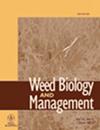Asian spiderflower ( Cleome viscosa ) germination ecology in southern Iran
IF 1.5
4区 农林科学
Q3 AGRONOMY
引用次数: 2
Abstract
Cleome viscosa is one of the most important weeds of warm‐season crops in southern Iran. Laboratory experiments were conducted to assess the impact of environmental factors on seed germination of C. viscosa. Freshly harvested seeds exhibited dormancy that was relieved (>90%) after immersion for 20 min in concentrated sulfuric acid. Regardless of the temperature regime, the final percentage of germination in light/dark (69.3%) was significantly higher than in complete darkness (58.3%). The optimum temperature for germination was 35/25°C in both light and dark. No germination was observed at constant temperatures of either 15 or 45°C. The thermal thresholds for seed germination, the base (Tb) and the mean ceiling germination temperatures (Tc₍₅₀₎) were estimated to be 18.8 and 39.9°C, respectively. A base water potential (Ψb₍₅₀₎) of −0.96 MPa was identified for C. viscosa seeds. The response threshold of C. viscosa to reduce 50% of maximum germination for salinity was estimated to be 255 mM. Seeds that were placed on the soil surface had the highest percentage of seedling emergence (77.3%), and no seedlings emerged from seeds placed at a depth of 6 cm. The findings of this study could help to improve the integrated weed management strategies for this species.伊朗南部亚洲蜘蛛花的萌发生态学
粘草是伊朗南部暖季作物中最重要的杂草之一。通过室内试验,探讨了环境因素对粘草种子萌发的影响。新鲜收获的种子在浓硫酸中浸泡20分钟后休眠解除(约90%)。在不同温度条件下,光照/黑暗条件下的最终发芽率(69.3%)显著高于完全黑暗条件下的最终发芽率(58.3%)。在光照和黑暗条件下,最适萌发温度均为35/25℃。在15°C或45°C的恒温条件下均未观察到萌发。种子萌发的热阈值,基础(Tb)和平均上限萌发温度(Tc₍₅₀₎)分别估计为18.8和39.9°C。经鉴定,粘草种子的碱水势(Ψb₍₅₀₎)为- 0.96 MPa。粘胶菊对盐度降低最大萌发50%的响应阈值估计为255 mM。土壤表层种子出苗率最高(77.3%),埋于6 cm深度种子无出苗率。本研究结果将有助于改进该物种的杂草综合管理策略。
本文章由计算机程序翻译,如有差异,请以英文原文为准。
求助全文
约1分钟内获得全文
求助全文
来源期刊

Weed Biology and Management
农林科学-农艺学
CiteScore
2.70
自引率
0.00%
发文量
13
审稿时长
>36 weeks
期刊介绍:
Weed Biology and Management is an international journal, published four times per year. The journal accepts contributions in the form of original research and review articles in all aspects of weed science. Contributions from weed scientists in the Asia–Pacific region are particularly welcomed.
The content of the contributions may relate to weed taxonomy, ecology and physiology, weed management and control methodologies, herbicide behaviors in plants, soils and environment, utilization of weeds and other aspects of weed science. All contributions must be of sufficient quality to extend our knowledge in weed science.
 求助内容:
求助内容: 应助结果提醒方式:
应助结果提醒方式:


